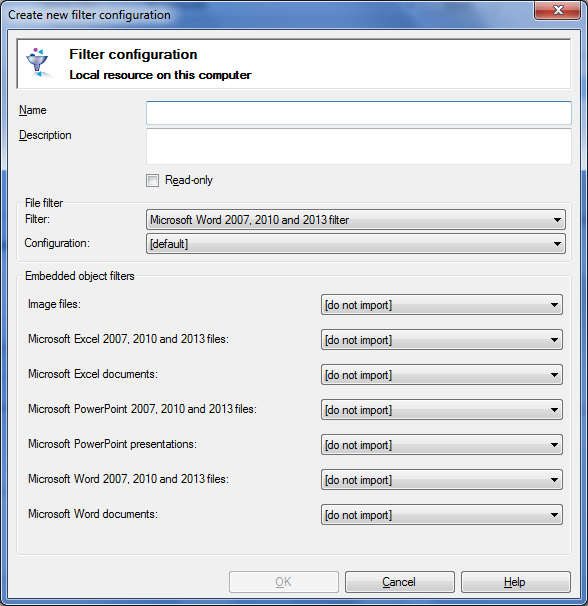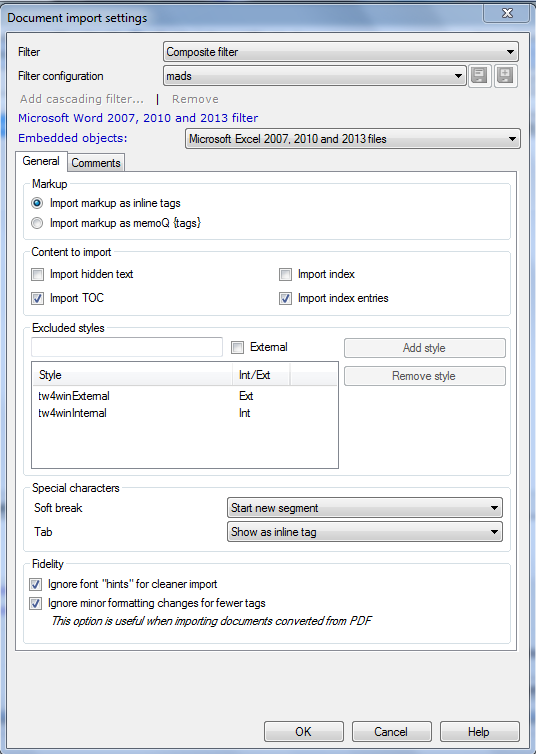|
memoQ supports the import of embedded objects from MS Office X files (DOCX, XLSX, PPTX). The embedded files themselves can be of any format which is supported both by memoQ and MS Office (this includes, besides MS Office formats, HTML, XML and PDF, and image formats). How to beginOn the Documents ribbon tab, click the Import With Options button, then select Change filter and configuration to display the Document import settings dialog. Select a composite filter from the Filter drop-down list for your documents, then choose the filter configuration for the composite filter from the Filter configuration drop-down list.. You can create a composite filter in the Resource console. In the Resource console > Filter configurations, click Create filter for embedded documents.
Enter a filter name in the Name field. Enter a description in the Description field (optional). If you want to make this filter read-only, check the Read-only check box. In the File filter section, choose a filter from the Filter drop-down list. Here only MS Office X formats can be chosen: DOCX, XLSX or PPTX filters. If you have created filters for these formats, you can choose them from the Configuration drop-down list. Otherwise, the default import filter for the MS Office X formats is selected by default. A filter is considered compatible with a filter if it is either a corresponding configuration, or it is a chained configuration that starts with a corresponding configuration. In the Embedded object filters section, choose which embedded objects should be imported or not. Configure the embedded object types that you wish to import from a document: Image files, Excel, Word or PowerPoint (MS Office X formats). NavigationClick OK to create the composite filter. Click Cancel to cancel the filter configuration. When you import documents into your memoQ project, you can choose the composite filter in the Document import options dialog, or click the Change filter and configuration link. In the Document import settings dialog, choose the Composite (embedded) filter:
The header consists of two rows: the top row contains a link button with the name of the file filter. The bottom row contains a link button Embedded objects and a drop-down list containing the list of embedded object types that were configured to be imported when the filter was created. When the file filter link in the first line is clicked, the bottom pane shows the configuration control of the file filter. When you either click the Embedded objects link, or you choose an element of the drop-down list then the corresponding configuration editing control is shown in the bottom pane. Note: When you choose the composite filter in the Document import options, you cannot change settings, e.g. if you have set the Image files to [do not import]in the filter configuration, you cannot change it to import. You need to edit the filter in the Resource console. The Save buttons in the Document import settings dialog are grayed out for the composite filter. Note: You cannot add a cascading filter when you use a composite filter. If you choose a filter other than the Composite (embedded) filter in the Document import options, then the 2 check boxes Import embedded objects and Import embedded images in the New documents section of the Document import options dialog determine if embedded images or objects are extracted or not. If you check these check boxes, then embedded objects and images are extracted using the corresponding default configurations for each found object. If you choose a Composite (embedded) filter configuration a document, then the extraction of the embedded objects and images is determined solely by the selected composite configuration. If an object type is configured to [do not import] then it is not going to be imported. Otherwise, the selected configuration is used to import the given embedded object.
See also: |

